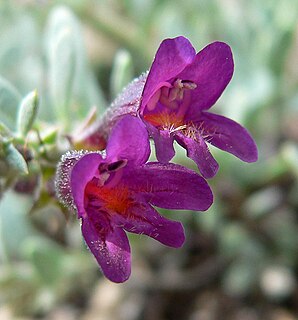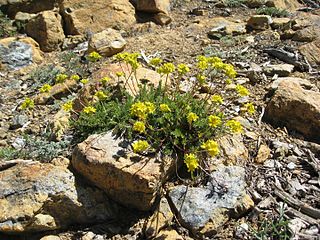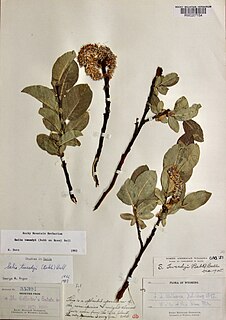
Plantago is a genus of about 200 species of flowering plants in the family Plantaginaceae, commonly called plantains or fleaworts. The common name plantain is shared with the unrelated cooking plantain. Most are herbaceous plants, though a few are subshrubs growing to 60 cm (24 in) tall.

Alisma plantago-aquatica, also known as European water-plantain, common water-plantain or mad-dog weed, is a perennial flowering aquatic plant widespread across most of Europe and Asia from Portugal and Morocco to Japan, Kamchatka and Vietnam. It is also regarded as native in northern and central Africa as far south as Tanzania, and in Australia. It is reportedly naturalized in southern Africa, New Zealand, Alaska, British Columbia, Washington state and Connecticut. Some sources maintain that the species is widespread across North America, but these reports appear to have been based on misidentified specimens. It is found on mud or in fresh waters.

Plantago major, the broadleaf plantain, white man's foot, or greater plantain, is a species of flowering plant in the plantain family Plantaginaceae. The plant is native to most of Europe and northern and central Asia, but has widely naturalised elsewhere in the world.

Plantago maritima, the sea plantain, seaside plantain or goose tongue, is a species of flowering plant in the plantain family Plantaginaceae. It has a subcosmopolitan distribution in temperate and Arctic regions, native to most of Europe, northwest Africa, northern and central Asia, northern North America, and southern South America.

Lewisiopsis tweedyi is a flowering plant and sole species in genus Lewisiopsis. The species, formerly known as Cistanthe tweedyi and Lewisia tweedyi, is now classified in the family Montiaceae. The plant is known by the common names Tweedy's pussypaws, Tweedy's lewisia, or Tweedy's bitterroot. It is endemic to western North America in north-central Washington and adjacent British Columbia. It commonly grows on well-drained slopes often on rocky slopes or in rock crevices from low elevation ponderosa pine sites up to the drier part of the Grand Fir zone of the North Cascades. The flowers usually have a coral, apricot, or pink color.

Penstemon thompsoniae, Thompson's beardtongue, is a low perennial plant endemic to the southwestern United States, where it grows in dry shrublands, woodlands and forests. It is considered a species of conservation concern in California.

Plantago patagonica is a species of plantain known by the common name woolly plantain. It is native to much of North America, including the southern half of Canada, the western and central United States, and northern Mexico, and parts of southern South America. It grows in many types of habitat, including grassland and woodlands. It is a hairy annual herb producing linear or very narrowly lance-shaped basal leaves up to 10 centimeters long. There are usually many stemlike inflorescences growing erect to a maximum height around 18 centimeters. Atop the peduncle of the inflorescence is a dense cylindrical or somewhat conical spike of several tiny flowers and bracts. The spike is very woolly.

Plantago rugelii is an edible species of flowering plant in the plantain family, Plantaginaceae. It is native to North America, where it occurs in eastern Canada and the central and eastern United States. Its common names include American plantain, blackseed plantain, pale plantain, and Rugel's plantain. The species name rugelii honors Ferdinand Ignatius Xavier Rugel (1806-1879), a German-born botanist and pharmacist.
Muhlenbergia orophila is a grass species native to Guatemala and to Mexico as far north as the Distrito Federal. The type specimen was collected from an alpine meadow at an elevation of approximately 3750 m near the Summit of Sierra de las Cuchumantanes, a remote mountainous area in el Departamento de Huehuetenango in the western part of Guatemala.

Erigeron tweedyi, or Tweedy's fleabane, is a perennial herb in the daisy family. It is native to the Rocky Mountains in Montana, Idaho and Wyoming.
Guardiola platyphylla, the Apache plant, is a North American species of plants in the sunflower family, native to Mexico and the southwestern United States. It is found in northwestern Mexico and the southwestern United States.

Frank Tweedy (1854–1937) was an American topographer and botanist. He worked on pioneering surveys first in the Adirondacks, and then in the American West. He also made major contributions to our knowledge of the western flora and vegetation. He is perhaps best known for his studies in Yellowstone National Park.

Astragalus tweedyi, or Tweedy's milkvetch, is a perennial herb in the pea family. It is native to Washington and Oregon in the Pacific Northwest of the United States.

Ivesia tweedyi, Tweedy's mousetail or Tweedy's ivesia, is a perennial herb in the rose family. It is native to the Pacific Northwest in the United States, from Washington east to westernmost Montana.

Chionophila tweedyi, or Tweedy's snowlover, is a perennial herb in the plantain family. It is native to Idaho and Montana in the western United States.

Calamagrostis tweedyi, the Cascade reedgrass or Tweedy's reedgrass, is a perennial in the grass family. It is native to the Pacific Northwest in the United States, in Washington, Oregon, Idaho, and Montana.

Desmodium tweedyi is an herbaceous flowering plant in the pea family native to northern Texas and southern Oklahoma popularly known as "Tweedy's ticktrefoil" or "tick-clover." The legume or seed pod it produces has given the species its common names from its ability to cling to clothing. Along with other species in the Desmodium genus, D. tweedyi has become a candidate for soil enrichment, suppression of insect pests, mulch and green manure production, and making "good fodder for animals including bobwhite, turkey, grouse, deer, cattle and goats.”

Gilia tweedyi, or Tweedy's gilia, is an annual plant in the phlox family. It is native to the northwestern United States.

Salix tweedyi, or Tweedy's willow, is a shrub in the willow family. It is native to the northwestern United States.


















